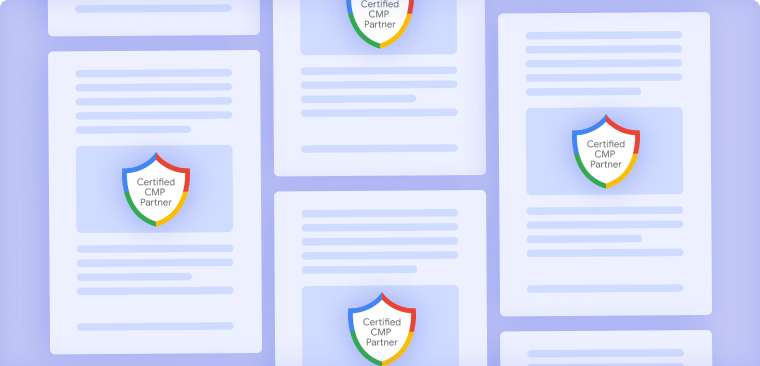Geo-Targeted Consent Banners: How Smart CMPs Boost GDPR Compliance and UX
November 06, 2025
•
3 min read
Table of contents
back
to the top
Geo-Targeted Consent Banners: How Smart CMPs Boost GDPR Compliance and UX
Under the GDPR, websites must get clear permission from users before using non-essential cookies or trackers. But applying the same consent experience to every website visitor can cause friction, reduce engagement, and even lead to non-compliance.
That's where geo-targeted consent banners come in.
By tailoring banner behavior based on the visitor's geographic location, businesses can serve compliant, localized, and user-friendly consent notices particularly within the EU and UK, where GDPR applies.
In this blog, we break down how geo-targeting works in a GDPR context, why it matters, and how a modern Consent Management Platform (CMP) can help you implement it efficiently.
What Are Geo-Targeted Consent Banners?
A geo-targeted consent banner uses IP-based geolocation to detect where a user is browsing from. If the visitor is from a country governed by the GDPR (such as France, Germany, Spain, or the UK), the website presents a banner that aligns with the GDPR's strict consent requirements.
If the visitor is outside the EU/UK, the banner can be adjusted or omitted based on business policy.
This approach helps businesses:
- Meet GDPR requirements for users in applicable regions
- Avoid unnecessary consent prompts for users not covered by the regulation
- Provide a more seamless experience overall
Why Geo-Targeting Matters Under GDPR
GDPR applies to any website that targets users in the EU or UK, regardless of the business's physical location. It mandates that:
-
Users must give explicit, informed, and freely given consent for cookies and trackers that are not strictly necessary.
-
Consent must be granular, allowing users to choose categories of cookies (e.g., marketing, analytics).
-
Users must be able to withdraw consent as easily as they gave it.
Without geo-targeting, websites face two risks:
-
Non-compliance by failing to collect valid consent from EU/UK visitors
-
Poor user experience by showing intrusive banners unnecessarily to other users
Smart geo-targeting ensures compliance where required, and minimizes friction elsewhere.
How a CMP Enables GDPR-Compliant Geo-Targeting
Modern CMPs offer tools that allow you to implement GDPR-specific banners only for users where it's legally required.
Key Features Include:
-
IP-Based Detection: Automatically identifies a visitor's location and determines whether GDPR applies.
-
Conditional Banner Display: Configure banners to appear only in specific geographies (e.g., EU and UK), reducing banner fatigue for global users.
-
Localized Language Support: Serve banners in the user's language for greater transparency and improved consent rates.
-
Consent Logs and Proof: Store detailed metadata about when and how consent was given, a must-have in the event of a GDPR audit.
Benefits of GDPR-Focused Geo-Targeting
1. Enhanced Compliance
Serve GDPR-compliant consent banners only to users who need them, reducing regulatory exposure.
2. Improved User Experience
Minimize disruption for non-EU visitors by showing less invasive notices or none at all.
3. Higher Consent Rates
Tailored, localized, and legally accurate banners lead to more trust --- and more opt-ins.
4. Audit-Ready Documentation
Easily generate consent logs by region to demonstrate lawful processing if regulators come knocking.
Best Practices for GDPR Geo-Targeting
-
Use a CMP with reliable geo-detection
-
Design GDPR-specific banner templates with clear, granular controls
-
Enable language auto-detection for multilingual users
-
Log every consent interaction including timestamps and banner > version
-
Regularly review regional updates from authorities like CNIL, ICO, > or NOYB
Final Takeaway
If your website receives traffic from the EU or UK, GDPR compliance isn't optional --- it's required. Geo-targeted consent banners offer the most efficient way to ensure you only ask for consent where the law mandates it, and avoid irritating users elsewhere.
A GDPR-smart CMP helps automate this process - ensuring you remain compliant, build user trust, and streamline operations across regulated regions.
Sources
-
GDPR Article 7 -- Conditions for Consent
-
CNIL -- Guidelines on Consent
-
UK ICO -- Cookie Consent Guidance
Explore further

The Difference Between Consent Mode v1 and v2 Made Simple
Google's Consent Mode v2 improves privacy compliance while maintaining analytics and ad tracking. This guide covers key updates and how to implement them for better data accuracy.
March 17, 2025
4 min

The Role of Data Protection Officers (DPOs) in GDPR Compliance
In today’s digital landscape, protecting personal data has become a vital concern for organisations.
September 16, 2024
4 min

What is Consent Fatigue and How Brands can Fight It
Tired of endless cookie pop-ups? Discover how consent fatigue erodes trust — and how ethical CMP design, smart timing, and real choice can boost compliance and loyalty.
June 13, 2025
6 min


